Altai Mountains
Altay Mountains:
Area: Western Siberia, south, Altai mountains (3.5 hours from Moscow by plane, 48 hours by train).
Nearest cities: Gorno-Altaysk, Barnaul (300km), Novosibirsk (600km).
Activities: trekking, rafting, hiking, climbing, horseriding
Tours at Altay Mountains - a list of recommended trips - click here
The name "Altay" (or "Altai") comes from Mongolian "Altan", which means "golden". Altay mountains are truly one of the nature's most marvelous gems, amazing by its diversity and beauty.
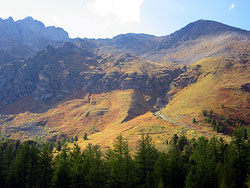 |
The Altay ecoregion covers vast 845,000 square kilometer area at the junction of four countries: Russia (largest part), Kazakhstan, Mongolia and China. Novosibirsk, the city through which the Trans-Siberian route goes, is about 600 km far, which is very not far for Siberian scales.
Altay is a land where myths and legends are incarnated into reality. It's one of those rare corners on the Earth where Nature decided to show everything it was capable of. Broad and boundless views of steppes, luxuriant varieties of taiga thickets, modest charm of deserts, severe splendor of snowy peaks, laconic beauty of tundra - the diversity of landscapes here is so rich, it is as if you are turning over pages of a geographical atlas!
Highlights.
Three major factors make Altay mountains a recreational domain of great value: amazing natural diversity (various landscapes, climates, abundance of wildlife); thin population, historically nomadic (Mongolian and Kazakh ethnos), who have a very natural way of life; and remoteness from any industries (the region lives only for tourism and agriculture). All this has ensured that Altay region stayed untouched by
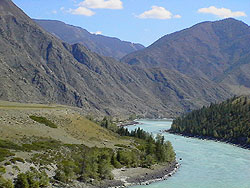 |
industrial development and is still a very natural place. Besides, such diversity makes it possible to involve in almost any possible activity: from rafting to trekking, from speleo to skiing.
Stretching for nearly 2000 km from north-west to south-east, Altai mountains form a natural border between the arid steppes of Mongolia and the rich taiga of Southern Siberia. Both climatic zones create the landscapes of striking diversity, ranging from the Mongolia-like steppes (at the area of Kosh-Agach village, south east) to those of the Swiss Alps (along Chuysky Trakt).
During the Soviet times, Altay was a mecca for adventure tourism, especially rafting. Altai mountains have a lot of rivers, Katun, Biya, and Chuya being the longest of them. There are also myriads of smaller mountain rivers that are fed by Altay's glaciers. Along all these rivers there's a lot of places for recreation and fishing. You can easily put a tent anywhere you want.
Altay's Nature.
The wildlife vary from big mammals (bear, lynx, glutton, Siberian stag, even reindeer and snow leopard above the tree line) to small birds (230 species) and fishes (20 species - umber, loach, white fish among them). Many species and plants are really unique.
Camel and yak are a good Mongolian touch to the picture of the Russian Altai. Another, and very pleasing touch is no mosquitoes and such-like making life miserable in Northern Siberia. Cedar is a very common tree in the rich mountain forests as well as pine, birch, spruce, fir, larch. Berries and mushrooms are abundant in the season.
There are four main plants that grow in Altay mountains and that are widely used by local people. On the photo below, from right to left are:
Cedar (Kedr) is a pine-like tree, its pines contain a lot of little nuts.
 You can cook the whole pine in fire or boil it and then take out the nuts, they are very tasty and nutricious. Badan is a plant that usually grows on heights starting from 1000 m and its dry (brown) leaves are used to make tea. Kuril tea is another nice plant to make tea with and has many positive effects also. Cannabis selvia is also quite widely spread.
You can cook the whole pine in fire or boil it and then take out the nuts, they are very tasty and nutricious. Badan is a plant that usually grows on heights starting from 1000 m and its dry (brown) leaves are used to make tea. Kuril tea is another nice plant to make tea with and has many positive effects also. Cannabis selvia is also quite widely spread.
Altay Weather.
The weather and climate at Altay is as diverse as its nature. Generally, the summer starts in May-June and finishes in September. During that time it's quite warm during the daytime (about 20 - 25 celcius) and cool in the night (about 5-10 celcius), so it's better to have a sleeping bag with you, if you are
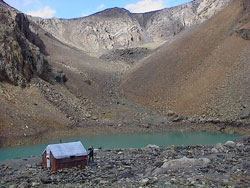 |
traveling on your own. During June and July there may be quite a few rains, but the August and September are the sunniest months (more than 60% of the time there's no rain at all). In the Summer the snow is left only on the heights of 2600 meters and higher. The winds in the valleys are not very strong. So, to sum everything up, the best months for traveling at Altay in Summer are July, August, and first half of September: warm, sunny in the day, no mosquitoes.
The winter in Altay starts in October-November. That's when it starts snowing and the mountains are covering by snow from top to bottom. The best months for traveling in winter are November and December. During that time, there's mostly good weather and not very cold. The coldest months are January and February. The average temperature goes down to minus 15-20 celcius. The coldest place at Altay is Chuyskaya steppe, which is along the way to Mongolia. After that, in February and March the weather is quite good again. There are a lot of activities possible, like skiing, auto tours, animal watching, and even swimming in frozen lakes. And, of course, the main activity: alpinism.
The snow usually starts to disappear in the first half of May, so it is a beatiful Spring time in Altay at this period.
Ethnography and Inhabitants.
For innumerable centuries being the cross-roads of human migration, the Altai has a long and rich history. A lot of archaeological finds prove that. Those
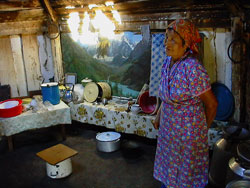 |
of the Ulalite paleolithic site (in the town of Gorno-Altaisk) are 900-800 thousand years old. So, man's ancestors lived in the Altai long before the pithecanthrope of Java. The number of younger sites (mainly in caves) comes to dozens. So, going from cave to burial mound, from graffito to graffito you will get the stereoscopic picture of man developing from the Stone to Bronze and Iron Ages. The modern population is a mixture of indigenous Altais and Russian settlers, some of the latter still leading in their villages the life of Old Believers, with strict rules and very much isolated from civilization. There are few remote villages in Altai where you can see wool being spun on a hand and hear traditional Altai throat singing (a very interesting and strange technique).
Best Places to Go:
Katun river starts its way near the highest point of Altai mountains (4620 m) and goes down through pristine alpine scenery, with a number of remote Altai villages along the way to Ob' river, that crosses the west Siberia from North to South and brings its waters to Karskoe more, in the ocean. Katun river is very good for
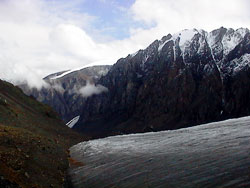 |
rafting as it offers many exciting routes and magnificient views at Altai mountains.
Altyn-Kyol (in Russian means "Golden Lake") is the native Altai name for Lake Teletskoye. This lake is considered to be a smaller replica of Baikal lake, however, we would not recommend you to go there, because it is quite unaccessable and there are rumours that it is polluted by the remains of Soviet space ships that were launched in 80s from Baikonur space (in Kazakhstan).
Aktru glacier is a beautiful and the most accessible of Altay's glaciers. It is located about 500 km along Chuyski trakt, which leads to Mongolia. You can arrive to Aktru alpinist base and make short 1-day walks to glaciers. The walks are not hard and picturesque, so perhaps Aktru is one of the best place to visit in Altay if you have more than 3 days. Aktru is also loved by snowboarders who ride there even in Summer months. It is a remote area and very pristine and clean. The best place to rest from civilization and enjoy the nature.
Beluha mountain is considered to be a sacred place. Local people believe that Belovodie (the region around Beluha) is where the new civilization will start. However strange it may sound, but historical researches prove that many civilizations started their way from this region. It is hard to access Beluha by car, the nearest village is Tungur, where there's a good alpinist base, and Beluha is within 3 days walk (or 2 days horseriding) from there.
The Cordon of Chelush is a lonely place on the shore of the amazing highland lake, not far from the mouth of a mountain river. It is only possible to get there by water or by helicopter. The picturesque landscapes of the cordon may give a great pleasure to the real connoisseurs of Natural beauties and wonders.
The Biya is the only river flowing out of Lake Teletskoye. A rafting journey down the Biya is considered a classic route of water tourism. The mixture of impetuous rapids and calm, extensive sections of the river allow enjoying the beauty of the surrounding landscapes and at the same time receive a sufficient dose of adrenalin.
Around 100-150 years ago there was a great mountain avalanche, but it couldn't stop the impetous Chulcha river and from a great height it falls down by cascades, forcing its way to the Chulyshman River – Uchar Waterfall (in Russian means "Unapproachable"). The Uchar Waterfall was discovered only about 20 years ago, so not many people have had a chance to see it yet.
Tours at Altay Mountains - a list of recommended trips - click here
Nearest Towns and How to Get There.
Altai montains is a quite remote region. The closest big (more than 50,000 inhabitants) city is Gorno-Altaisk, located just at the beginning of Altai mountains, on Katun river. Slightly further is Biysk. Many tourists go to one of these two cities, and it is a big mistake. Gorno-Altaysk and Biysk are completely run-down Soviet style cities with quite depressive mood. Besides,
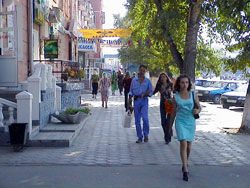 |
it's almost impossible to find a good guide from there.
We recommend you to go to Barnaul, which is 300 km far from Altay. It is a beautiful nice provincial town, which surprises with availability of good-quality accommodation ($3/night for western-style shared room!), original restaurants, and friendly people. Also, most Altay tour operators base in Barnaul, so it's a practical place to start your trip.
Novosibirsk (around 600 km far), which is located on Trans-Siberian railway, can also be a good starting point.
The most convenient way to get to Altay is to take a plane from Moscow to Barnaul (from $230 return, 4 hours flight) and then take a bus or personal mini-bus to Gorno-Altaisk.
The cheapest way to get to Altai area is to take a train from Moscow to Novosibirsk (from $70 one way), then take a train to Biysk (through Barnaul - about 370 km and $5 one way), then take a car or a bus (cheap) to Gorno-Altaisk (just at the beginning of Altai mountains) and further - take local buses to Altai mountains along Chuisky Trakt (the auto-road that goes through Altay to Mongolia).
Activities & Traveling around Altay.
Most outdoor activities can be practised in Altai: caving, climbing, mountaineering, trekking, hunting, rafting, paragliding, horse riding. Rafting has made Altai known not only in Russia and the Chuya Rafting Rally is an international event.



